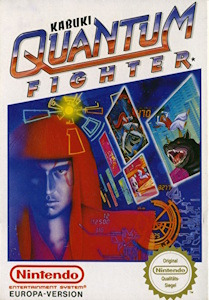
Kabuki: Quantum Fighter (1990-)
Developer: Human Entertainment
Publisher: Pack In Video | HAL Laboratory
Genre: Platform
Designer: Hiroyuki Ito
Composer: Masaki Hashimoto, Takahiro Wakuta
Kabuki: Quantum Fighter for the NES was developed by Human Entertainment and published in 1990 by Pack-In-Video and HAL Laboratory. The game was released exclusively for the NES, distinguishing itself as one of the more unique action titles on the console. While it never received any official ports to other systems, its originality and striking concept have kept it in the memory of many NES enthusiasts. The game’s unusual blend of kabuki theater and futuristic cyber-action set it apart from the more traditional platformers of the era, and it did not stem from a prequel or lead into a direct sequel, existing as a one-off experiment in design.
The narrative follows Colonel Scott O’Connor, who takes on the form of his kabuki-acting ancestor to battle a hostile computer virus inside a military supercomputer. This unusual premise combines Japanese cultural traditions with science-fiction themes, merging the flamboyant visuals of kabuki with the digital environments of a corrupted cyber-world. Players face off against a variety of enemies that take the form of rogue programs, corrupted data, and monstrous virus entities. The storyline reflects both a fascination with technology at the dawn of the 1990s and a creative attempt to weave theatrical flair into the platforming genre.
Gameplay consists of tight side-scrolling platform action, with Mowgli-inspired hair attacks serving as the main weapon—a distinctive twist that immediately set the game apart from its contemporaries. Players could use the character’s long red hair like a whip to strike enemies or swing across platforms, adding both combat utility and mobility to the mechanic. Levels required sharp reflexes, pattern recognition, and careful platforming, with a steady progression of difficulty that kept the experience challenging. The design also included thematic stage layouts, ranging from circuit-like structures to more surreal digital environments, all of which reinforced the idea of fighting inside a corrupted computer system.
The soundtrack, composed to match the game’s cybernetic atmosphere, provided energetic and driving tunes that elevated the intensity of battles and exploration. Its strong, memorable melodies helped underscore the sense of high-tech adventure while maintaining a cultural edge that tied back to the kabuki influence. Kabuki: Quantum Fighter did not have a sequel, but its style and mechanics have earned it a cult following among retro game fans. Promotion of the game emphasized its bizarre yet captivating premise and unique combat mechanics, and reception at the time was largely positive, with praise for its originality, graphical detail, and tight controls, though its high difficulty curve was seen as a barrier for some players.
Images from MobyGames
Buy Kabuki: Quantum Fighter
Click one of the Ebay or Amazon buttons below to check the latest prices and purchase Kabuki: Quantum Fighter for the Nintendo Entertainment System.

Related Searches
Kabuki: Quantum Fighter NES Download
Kabuki: Quantum Fighter is available to purchase and download from a range of vendors. Always shop around...
Kabuki: Quantum Fighter NES Manual
Various repositories around the internet have scanned and archived a range of retro manuals. Search now to.....
Kabuki: Quantum Fighter NES Rom
We don't host or link to rom sites for this game. However, there are many sites out there that may be...
Kabuki: Quantum Fighter NES Walkthrough
Many sites - particularly YouTube - host a range of walkthrough videos to guide you in your quest to get...
Kabuki: Quantum Fighter NES Cheats
There are various sites out there that can offer cheat codes for games. Search now to find all available...
Kabuki: Quantum Fighter NES Controls
This information can often be obtained through the user manual. Alternatively there are many sites out there...
Kabuki: Quantum Fighter NES Release Date
The initial release date for Kabuki: Quantum Fighter is stated as 21st December 1990. Other ports of the game may..
Kabuki: Quantum Fighter NES Review
There are many sites out there that have collated and documented historic reviews of this game. Search now...
Kabuki: Quantum Fighter Famicom
As a Nintendo Entertainment System release, this game was also likely also available on the Famicom. This....
Kabuki: Quantum Fighter NES Speedrun
There is now a community of competitive speedrunners who will try and gain the fastest possible time on their....








